Written by Debra Bourne - https://runningape.wordpress.com/
The 2020 edition of Centurion’s Autumn 100 was a very special race for me: 23 hours and 8 minutes of special. All my training over the past year paid off with my first sub-24-hour 100 mile race, earning me my first ‘100 miles – one day’ buckle.
In normal years this is the fourth and final race in the Centurion 100-mile Grand Slam (although this year the South Downs Way 100 is still to come). While the other three races – Thames Path 100, SDW 100 and North Downs Way 100 – are point-to-point along their respective National Trails, the A100 is a series of four 25-mile out-and-backs from Goring in Oxfordshire, with the first and fourth legs being on the Thames Path, while legs two and three use the Ridgeway.
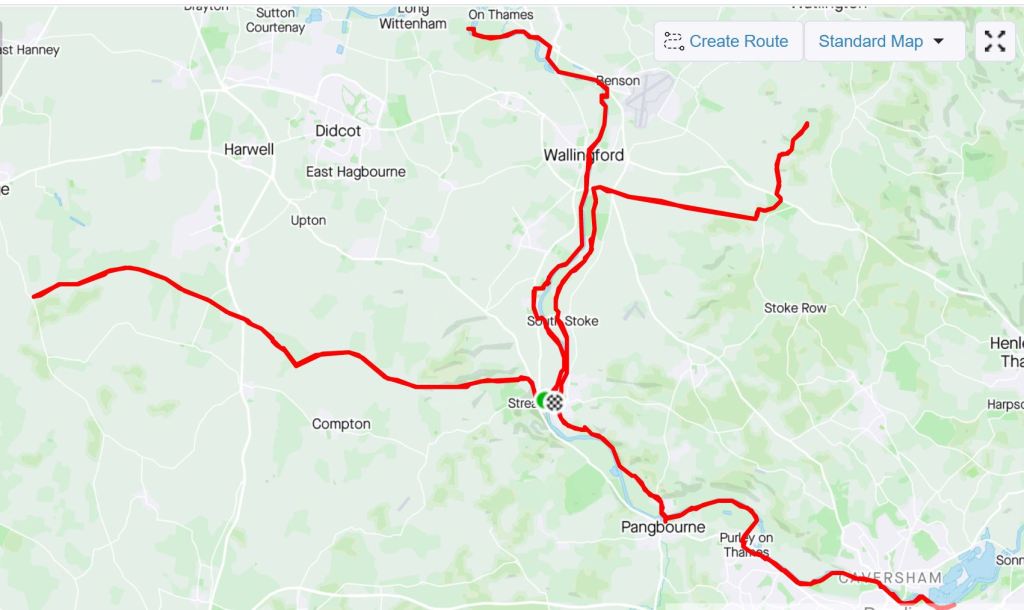
[Running trace for the A100]
The format means that runners can access their drop bags at 25, 50 and 75 miles. James Elson (the Race Director) in the briefing video had asked us to keep these as small as possible, and certainly no more than 50 litres, but that had to be balanced against bringing food I knew I would eat, plus some I might want, changes of footwear and adequate clothing options. I knew I probably wouldn’t use all the clobber I took (although I did eat most of the food), but it was good to have the choice.
As with CW50, we drove most of the way on Friday evening, staying overnight at the Travelodge in the M4 (this time without road closure worries). In the morning we were on our way by 6.30, after a bit of a wait for the windscreen to clear after a cold night. We arrived in Goring and I made use of the carpark toilets, avoiding any queue at race HQ or the Streatley start, then my husband Aidan carried my bag most of the way to the village hall before leaving me, with a kiss, as we had been requested not to bring anyone with us. I dropped off the drop bag, said hi to Nici, picked up and attached my tracker, then set off walking down the road to Streatley, setting my Garmin to ‘run’ and loading Leg 1 in as a course. I was using four courses, one for each leg, after discovering the miserly 50-waypoint limit on the Garmin 935. Many thanks to Chris Mills for chopping the course up for me after James posted the final version of the GPX. After the problems I’d had during NDW100 with the watch stopping recording the run when I hooked it up an external power source, this time I started off with the charger attached.
My coach, Neil Bryant, had suggested I run easy on the first leg and practice my eating and drinking breaks, get into a rhythm. About half a mile in there was a narrow humpbacked bridge, where we had to mask up and cross one at a time, guided by a lovely and very polite volunteer. I felt cold walking to the start at Streatley and for the first 5 or 10 minutes of running, but soon warmed up. From then on I used hat and gloves on and off to regulate temperature. It would have been easy to run faster than was sensible, given the flat route, and decent underfoot conditions. I didn’t stop at Wallingford, just said hi and got a great greeting from Anna Troup. Then onwards to the turn-around point at Little Wittenham, where I filled water bottles and took a satsuma and piece of banana. Keep on running, walking to eat and drink, getting practiced at juggling food and the powerbank which I was carrying in my left hand. Back through Wallingford, again without stopping, but Anna was very encouraging at a point where I was feeling quite low – I felt like I’d been pacing sensibly based on perceived effort, despite which my legs felt tired, which I hadn’t expected only about 20 miles into the race on flat terrain. Anna reminded me to enjoy the run!

[Along by the Thames]
The best aspect was the out-and-back nature of the course, which meant that I got to see all the other runners, the faster ones returning while I was still heading out, and the slower ones heading out while I was on the return journey. Some nice wildlife moments – watching swans take off from the river, and seeing Red Kites soaring overhead. It was great to see familiar faces such as Gareth Allen, Ollie Dawson and Rob Cowlin, as well as a load of others who are becoming familiar on the Centurion races. I did find the route a little boring, without the variety of a route such as the North Downs, but it was pleasant running and pleasant enough surroundings. After about 20 miles my laces started to press into the tendons on the tops of my feet. I stopped once and loosened them, but they started to hurt again in the last mile or so – it was definitely time to change shoes.
Back at Goring I experienced the fantastic Centurion organisation, with my drop bag pulled out and placed on a chair (those were at 2m distance from one another) while I sanitised my hands and filled my water bottles. I reported a lost glove – one of my really nice Inov8 ones, that had been a present – and hoped someone else would bring it in (although I did have a spare pair in my backpack). I sat down, changed shoes as fast as possible, and swapped my depleted bags of food (mixed vegan sweets, raisin-cranberry mix, salted snack pretzel sticks and boiled salted new potatoes) for full bags. I also took one of my hot cross buns to eat and a satsuma. Nothing else needed so I sanitised my hands – holding the bun and satsuma in a piece of kitchen towel kindly provided by a volunteer – and left, loading the course for leg 2 as I set off.
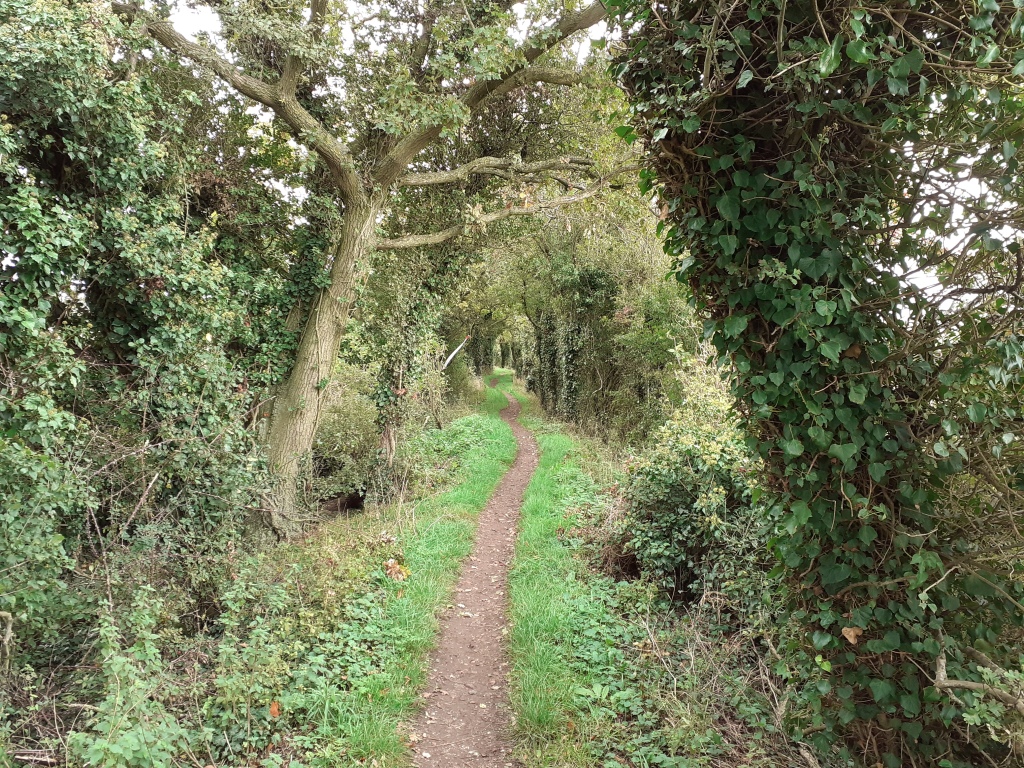
[Woodland path along the Ridgeway]
Leg 2 heads along the Ridgeway north then eastwards to Swyncombe and back. Initially the path lay alongside the river, on the opposite bank to the Thames Path, so the terrain was, not surprisingly, similar to that of the first leg. Past South Stoke on the little diversion off the Ridgeway that James had warned about, and into North Stoke, not really needing the aid station. Then over a road and into Grim’s Ditch. Here a volunteer in orange high-viz jacket warned us that the path was narrow and we should take extra care and give way to others. I rather enjoyed this section, roots and all; it was interesting to run it west to east for a change. I was meeting returning faster runners sooner this time and could only marvel at their speed as I stepped aside to let them pass. Another opportunity to say hi to people I knew as well. Gareth Allen seemed to be doing pretty well and looked much happier than when I’d seen him during NDW100.

[Heading into Grim’s Ditch]
Onwards, up and over some rolling hills. A large field, then another, dipping down then climbing up again towards woodland. At the far side I spotted Stuart March and stopped gazing at red kites for a few seconds while my photo was taken and we exchanged greetings, before I disappeared on the path through the trees. Onwards. Up the lane (I recognised this bit from going wrong on my CW50 recce) past St Botolph’s Church and into the aid station. Reach into my pocket for my mask… no mask. I realised I must have dropped it, so pulled a buff on instead. Sanitise, fill waters, take a bit of fruit, sanitise, thank the volunteers and head off back down the lane. By now some light showers had started, but they were not enough bother for me to put my coat on. Through the woodland, which anyway gave shelter from the rain. As I emerged and drew breath to say hi to Stuart as I passed, I spotted my face mask, which another runner had carefully placed on a gate post for me, and happily retrieved it.
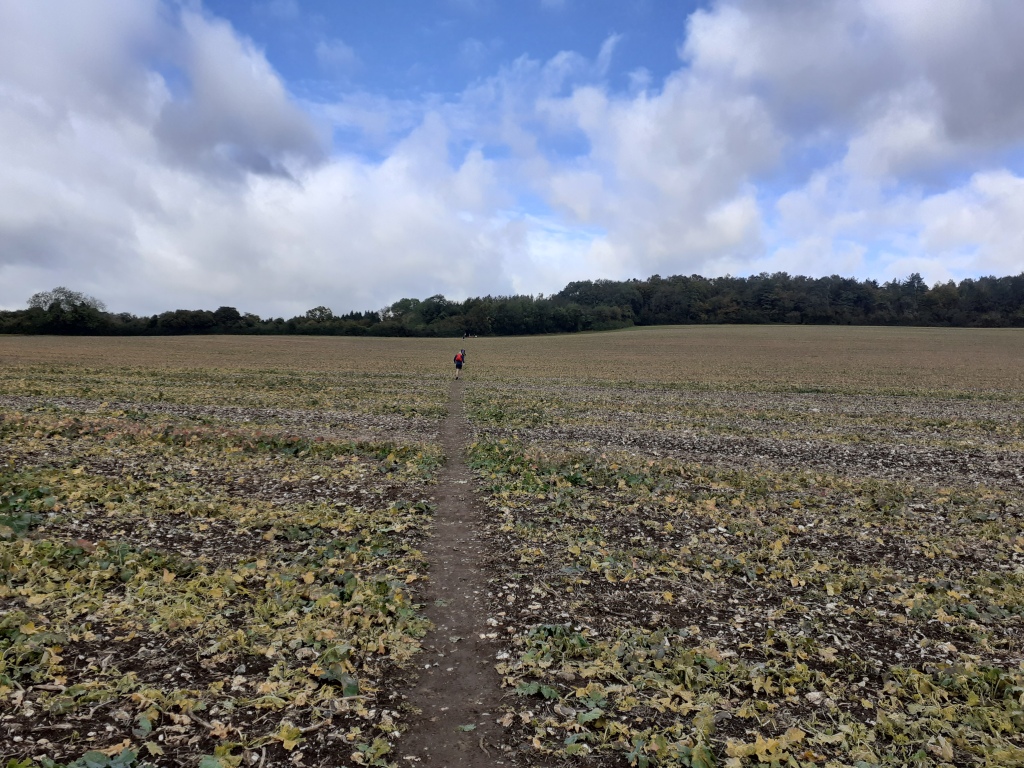
[Across the fields]
Across the two fields, running the inclines as well as the downhills because it had started raining again and I wanted to get back under sheltering trees. Another orange-coated volunteer as we plunged back down Grim’s Ditch, then over the lane and through North Stoke again before following the diversion to South Stoke, then back down the river. I passed Rob Cowlin again somewhere along here and worried as he was in road shoes and struggling on ground that was getting more slippery. The rain started again. Grey clouds stretching to the horizon suggested that this would be more than a shower, so I sheltered under a tree, dug my waterproof coat out of the backpack and donned it. Right decision, as the rain accompanied us all the way back to Goring. I was running mostly by myself, but there were a number of runners that I played ‘leapfrog’ with for shorter or longer periods throughout the race, depending on our personal running speeds, walking breaks, times spent at checkpoints and so on. Some I had met during other Centurion races, but with the minimal interactions under COVID-19 restrictions I was finding it hard to pin names and faces together.
Back down the alley, mask on and into the hall – where, to my delight, my glove was waiting for me! Fantastic. I had planned to change socks at this point but given the worsening weather I didn’t see the point – the ones I was wearing were not rubbing or anything and whatever I was wearing would get wet and muddy in the next hours, so it would be better to keep these on and change for a hopefully dry leg 4. Now stationary as I replenished my food supplies, I was starting to feel cold. It would get dark sometime during leg 3 and the temperature was likely to fall. What to wear? I pulled a long-sleeved running shirt on over the NDW50 shirt with my number pinned to it (I considered swapping the shirt, but then I would have needed to move the number), and pulled my waterproof trousers on as well as the jacket. They would protect me from windchill and from worry of getting soaked and cold if the rain got heavier, while leaving my long running tights dry in case I needed them for leg 4. With 50 miles done, I felt confident that my watch battery would last the rest of the time, so I left the charger and lead.
Out of the hall and off up the road, heading west on the Ridgeway. It felt strange to be running this section in the light, unlike either of my Ridgeway 86 runs. In a little while the rain eased and I was soon overheating, so I stopped for long enough to take the waterproof trousers off. A couple more miles and I was getting too hot again so took the jacket off – but before I could tie it round my waist the rain returned, so I put it back on – this time to stay on. This section was mainly wide chalk and flint paths, not too slippery yet, although I worried that might change with the rain. I was very aware on every down slope that I would meet it again as an incline later, but cheered myself on the uphills by thinking about returning down them. East Isley Downs was a lovely oasis of cheer, with little chemical lights edging the paths in and out, and volunteers making sure that people left in the correct direction outwards or inwards. I should have stopped there long enough to get my head torches out, but didn’t, because I wanted to clear the way for incoming runners.
As the light faded, and with the rain having paused, I get a couple of nice sunset pictures.
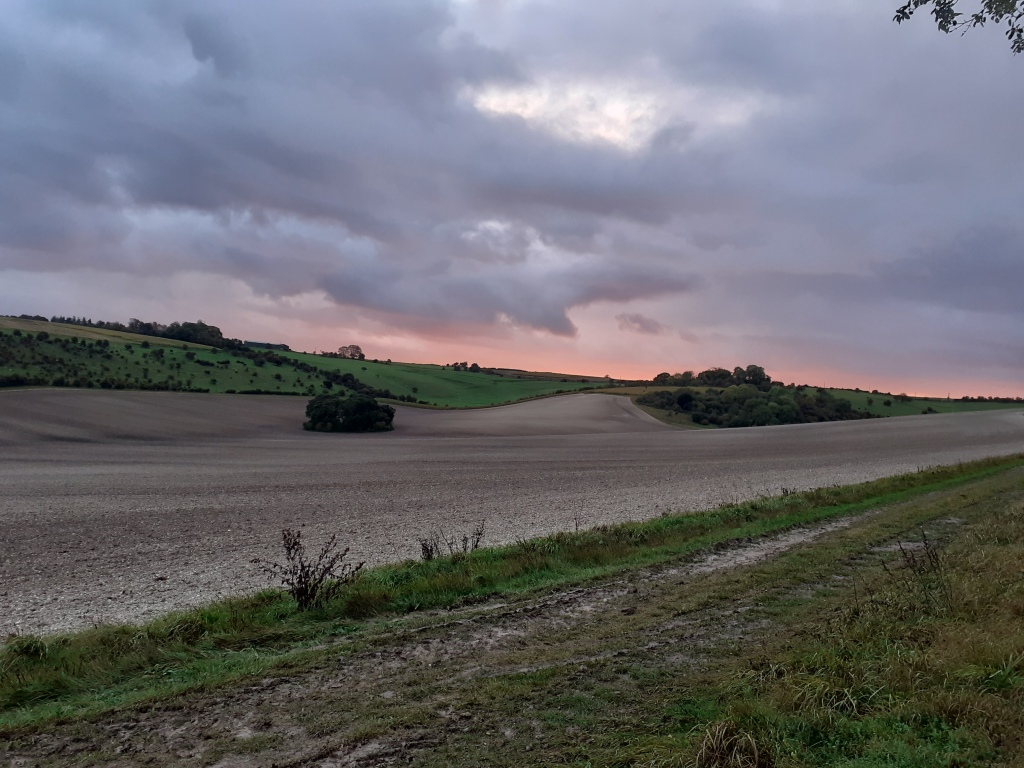
[Sunset on the Ridgeway]
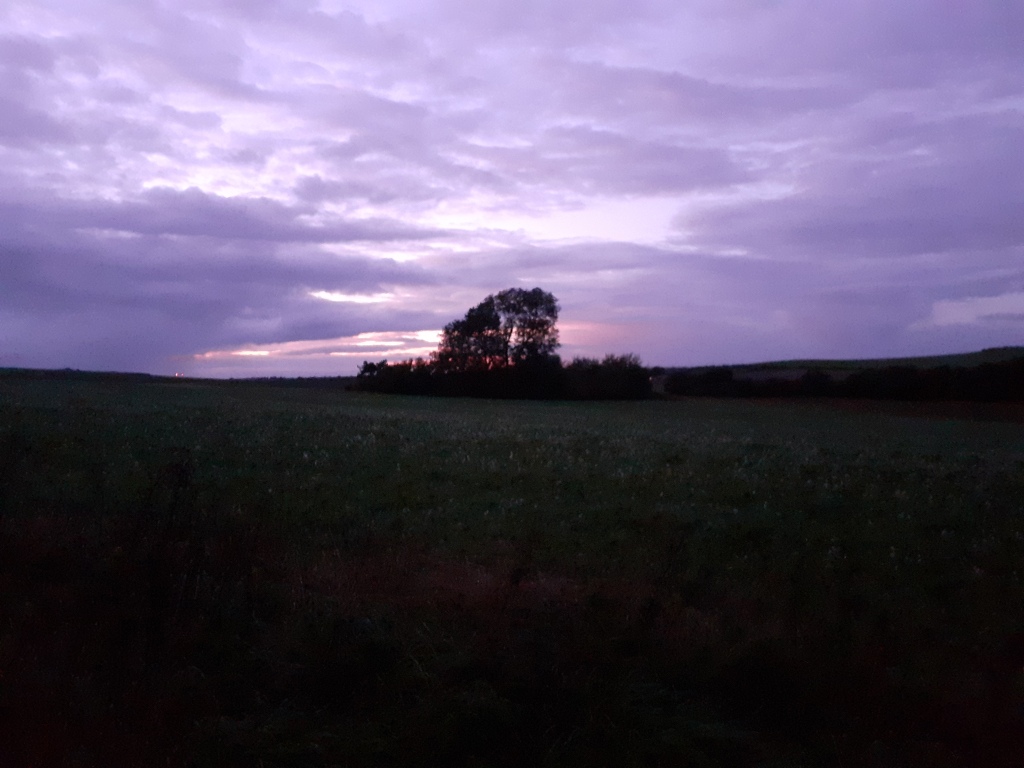
[Sunset on the Ridgeway]
Onwards, running where I could, walking when the footing seemed too treacherous or I was hunting for the best rut or ridge to run along. The last stretch before the turn-around point I bumped into Ollie Dawson and we ran together for a bit. He reassured me that I was well in time for my sub-24 goal. Finally into the aid station, buff on as I couldn’t find my face mask (again), fill water bottles, take a banana and set off again, taking cheer from the thought that the wind would now be behind me rather than into my face, and the muddiest section was first, so I could look forward to better footing later. Ollie had stopped to drink some coffee, which he said would help his upset stomach.
The rain had cleared and at one point I glanced up then stopped, turned out the headtorch and simply stood for a few seconds gazing at the wonderfully bright stars with no city light clutter to dim them. Back through East Isley Down aid station, then continuing back to Goring. I alternated running and walking, depending on the terrain and on how hot I was feeling, slowing when necessary to cool down. I felt I could probably run more and faster if I took a layer off, but I calculated that in the time it would take me to peel something off and stow it I would get too cold, so I just pushed my sleeves up my arms. At about 11pm, feeling a bit sleepy, I took a caffeine tablet and a little while later felt more alert. I didn’t spot Rob Cowlin on this section and realised he must have dropped, sadly. I was alone for long stretches, which I don’t mind, with other torches periodically approaching and passing, and sometimes seeing other patches of light down the trail and moving in the same direction as me, visible then hidden, depending on curves in the path. There was one very surreal moment when for a few seconds I saw what looked like balloons or something caught up in a tree ahead – then I realised it was a steep section of path and my torch was reflecting from a runner ahead of and above me.
At Goring, final replenishment of food from my drop bag and final hot-cross bun to eat, as well as changing headtorch batteries – the one in the main torch was still fine, but it made more sense to change it than not. I didn’t feel any need for hot food, so didn’t bother making up the instant noodles I’d brought. It was set to be a clear night and cold, according to the volunteers. I deposited the waterproof trousers into my drop bag and set off again. I was well prepared in case it was much colder by the river: I had a lightweight windproof and my arm warmers, in case I felt the need for another layer on my top half, and light Montane windproof trousers in case the legs got too cold, as well as thicker gloves, a beanie and a buff in the backpack. In the end I used none of these. Leg 4 set on the watch, plus other runners going the same way, supplemented the Centurion markings – not that the Centurion markings were lacking, just that I was tired.
Down to the river, along a little way. I spotted something on the path and stopped. It was a buff, evidently recently dropped, as it hadn’t been trampled, and almost certainly from an A100 runner, so I picked it up and stuffed it into the back of one of the vest pockets. Along a bit further then uphill and a section through undulating woodland, which I really hadn’t expected. However, that, for me, was the highlight of the section. The remainder was almost dead flat and most of it was rather dull. Despite Ollie telling me I had plenty of time for sub-24 I was worried about not making it. My legs were not really stiff or sore, but keeping them running, rather than walking, was getting more and more difficult. I started setting myself goals: 100 running strides with each leg then I could walk for 50 strides. Repeat. If I didn’t reach the 100, then I tried to make the following walking break shorter. As an added complication, my guts started telling me that a visit to the toilet would be a good idea. This ‘suggestion’ became more insistent and I had to walk, along a road, through a churchyard. I was NOT going to squat in a churchyard. By now I had lost track of whereabouts the intermediate aid stations would be, so when I spotted a lit-up building with people moving about inside it didn’t immediately occur to me that this was the checkpoint. I I had already decided to knock on the door and hope someone (a) answered and (b) let me use a toilet when I saw the Centurion arrows directing me there and realised with relief that this was the aid station. I shuffled to the door: ‘please tell me there’s a toilet!” ‘Yes’ came the welcome reply. It was up the stairs. That was okay, I could manage that. I fished in my pocket, couldn’t find my mask, so took a single-use mask from the pack by the door, sanitised my hands and hurried upstairs. Soon, somewhat relieved (pun intended!), I took a bit of banana from the aid tables, thanked all the volunteers and continued.
Across a couple of fields, past some dark cattle, their eyes brightly reflecting my headtorch, along by the river. Through a bit of woodland then suddenly, it seemed, into a built-up area, up a road, going a little past a junction but slowing and checking and turning back, my watch buzzing at me just as a couple of other runners whistled to alert me that I had missed the turning. A bit further along roads. I was sure I had already gone about eight miles, and Ollie had warned me that the checkpoint was six miles after the ‘Welcome to Reading’ sign. Where was that sign? After what seemed an age, I spotted it. Another six miles out. My heart sank. Nothing to be done except keep moving. Walk, run, walk, run. I was too warm when I ran, too cold once I dropped to a walk, so I seemed to be constantly taking my gloves off and putting them on again as well as pushing my sleeves up and pulling them down. I thought of removing a layer but was worried that I would get too chilled if I did. One interesting bit where I passed a huge gathering of roosting swans and geese, and a couple of lit-up bridges, but otherwise, being dark, not a lot of interest. About 2.30 or 3 am I took another caffeine tablet.

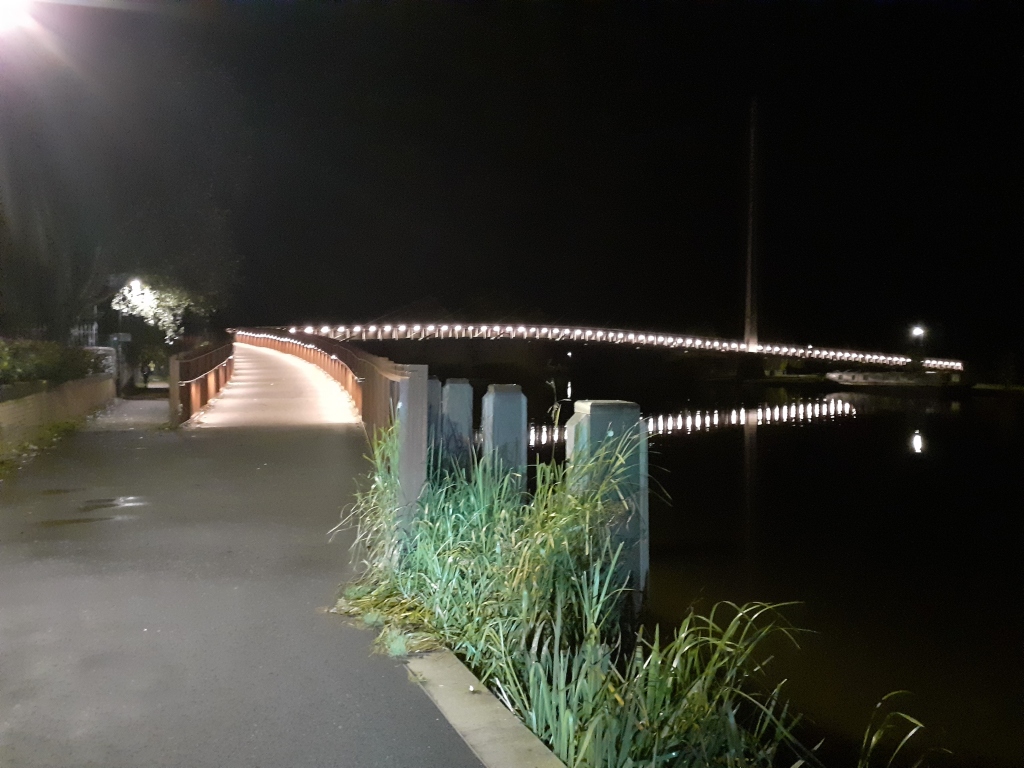
By this time I had ‘ultramarathon brain’ sufficiently that I couldn’t manage the calculations for how much longer it would be to the turn-around point, nor how much longer I had if I was to finish under 24 hours. A couple of times other runners passed me and I tried to tag on behind them, but always broke into a walk after 100 paces or so. I asked a returning runner how far… ‘about another mile or two’. Surely not? It was indeed nearly a further two miles. I spent a good mile expecting to see it round every corner, but finally, finally there it was!
Water, a banana (I think) and off again, definitely happier to be heading back. So much of running ultras is a mental game. I had been depressed by the elusive Reading checkpoint, but now I could tell myself there were only 12 and a half miles to go, and surely I could make that sub-24.
Despite feeling mentally better I still couldn’t maintain a run, so I went on run-walking and reminding myself to eat and drink. Back past the roosting waterfowl, back past the bridges. When the leg 4 trace said that I had about 8 miles to go, I dug my phone out and called my wonderful husband. ‘I’ve got somewhere between two and two and a half hours to go. Probably two and a half’. ‘Okay, I’ll send you a text when I reach the car park.’ Onward, back onto the road section, past the cows, Pangbourne Meadow, always giving a ‘well done’ to runners still on that outward leg. Another brief stop at the part-way checkpoint. Now less than 4 miles to go! My stomach was feeling a bit uncomfortable, but much less so than on NDW100, and I could still run in short but frequent bursts, walking at a good pace in between.

Up the road, striding into the incline, looking forward to the trail through the woods and the descent on the other side. I stepped aside for some runners who were catching me up, but they soon slowed and I caught them again. The front runner was pacing one of the others, aiming to get him finished in sub-24, and the other guy had the same aim. I said I was also trying for that. ‘Come on, girl!’ the pacer called, so I joined them, and after a few minutes found that I was generally managing to keep up with the pacer better than the other runners were doing, although none of the three of us could keep running for long before dropping back to a walk. Finally we were down back by the river. Nearly there now. A couple more turns, then onto the road. A final effort, running alongside the wall encircling the green, then over the timing mat. Finished! I pressed the button on my Garmin and walked down the alley, pulling my buff over my face, towards the Garden Room.
I knew that I had come in under 24 hours, but not how much under until I looked at my watch (and discovered it still running, so I pressed stop more firmly!) – it said 23:08. No way! What a fantastic result for my 90th ultra! I had to wait a little until this could be verified from the Centurion system, before I was allowed to pick up one of the coveted ‘100 miles – one day’ buckles and pose, grinning, for my finish line photos. I was given my T-shirt and offered tea and chilli. Veggie chili was available, and I felt bad for refusing it, but I didn’t think it was wise on an unhappy stomach.
My phone chimed, but when I looked I didn’t seem to have a text, so I accepted the offer of a tea and a sit down inside the hall. Various runners were draped over the carefully spaced chairs. I accepted my drop bag for the last time, and placed the shirt and buckle into it so I couldn’t lose them. A few minutes of chat with Nici and volunteers, then just as someone presented me with my tea I saw the text from Aidan and replied. A couple more minutes and some sips of tea, then I levered myself out of the chair, hauled my drop bag onto my shoulder, thanked everyone one last time and headed out.


[Finished! Earned my first “100 miles – One Day buckle”]
Afterword & thanks
It has been ten months since I contacted Centurion Coaching and Neil Bryant started setting my running schedule, making my training more focused. Having spent the past three years running lots of marathons and ultras, and qualifying for the 100 Marathon Club, I had wanted to see if I could get faster. My stated goals had been a marathon under 3:40 (maybe even under 3:30), Comrades under 10 hours and a 100-miler at sub-24 hours. The COVID-19 outbreak meant no Comrades, and with most of my other ultras postponed and squeezed into the last 5 months of the year, no way of fitting in an attempt at a fast marathon. That left the sub-24 goal. Massive PBs at 5K and 10K over the summer in virtual challenges (including the England Athletics 5K virtual championships) had shown that my training was improving my speed at those shorter distances, but I wasn’t sure how this would translate into ultra-distance performance.
I had coped better than most with the heat during NDW100, as shown by my 4th woman, 1st FV50, 22nd overall placing, which had been fantastic, but I hadn’t gone under 24 hours – although I tried to remind myself that only 17 runners HAD gone sub-24 in the race. This time my placing wasn’t quite as good – 1st FV50 again, but 6th woman and 77th overall, but I was delighted with my finish time of 23:08:38 – which set a new FV50 record for the course by more than 27 minutes.
Now I have beaten the 24 hours once, I know I can do it again and I’m sure I will. Lots to learn still, as it was mental/neurological fatigue rather than tired muscles that slowed me down in the last 25 miles, and I need to improve my nutrition to keep my stomach happier.
I have lots of people to thank. First, my wonderful husband for his support throughout my training, as well as getting up at 5am two mornings in a row to drop me off and pick me up again, and walking back to the village hall with the tracker when I realised, sitting in the car park, that it was still on my backpack.
Many thanks of course to James, Nici and the whole of the Centurion crew. It takes a huge amount of work behind the scenes plus the efforts of dozens of volunteers for a race like this to go ahead, and the organisation was spot-on. Thank you to Anna Troup, for reminding me to enjoy the race, thank you to the other runners who returned my glove and left my mask on the post, thanks to all the runners and volunteers who gave me encouragement during the race. The sense of community in ultrarunning is wonderful.
Special thanks to Neil Bryant, whose coaching has led me to find an extra gear and reach this goal. I also owe thanks to Chris Morton from my club, Striders of Croydon, whose speed sessions over the last year, and encouragement with the 5K and 10K virtual races, have really helped me to push harder and get more out of my speed work.

